Ryan Hall's Blog, page 298
January 21, 2016
2016 New York City Marathon Application Window Has Opened
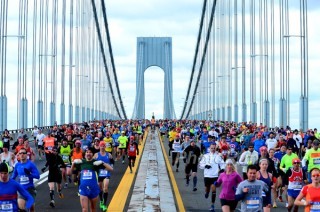
Photo: PhotoRun.net
For those interested in running the 2016 New York City Marathon, now’s the time to apply. The race will be held on Nov. 6 and send runners through the city’s five boroughs from Staten Island to Central Park.
The application process opened at noon ET on Thursday and will stay open until Feb. 21. This one-month window is for those interested in entering the lottery, as well as those applying for guaranteed entry.
RELATED: 45 Reasons We Love the NYC Marathon!
Guaranteed entry can be obtained a few ways:
— If you officially canceled your 2015 entry.
— If you have completed 15 previous New York City Marathons.
— If you are a time qualifier (view the standards here).
— If you take part in NYRR’s 9+1 program.
Last year, more than 80,000 runners applied for non-guaranteed entry, and just 18 percent of applicants were accepted. The lottery for the 2016 race will take place on March 8.
RELATED: Images from the 2015 New York City Marathon
RELATED: Other Ways to Enter the 2016 New York City Marathon
The post 2016 New York City Marathon Application Window Has Opened appeared first on Competitor.com.
January 20, 2016
Interview: Ryan Hall On Retirement, His Career, Training and More
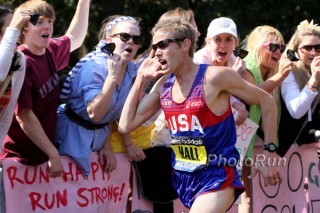
Hall said the 2011 Boston Marathon "best exemplified who I am as a runner, always going to the front and pushing as hard as I can for as long as I can and going to battle." Photo: PhotoRun.net
American marathoner Ryan Hall surprised the running world last Friday when he announced his retirement, citing massive fatigue brought on by chronically low testosterone levels.
We caught up with the 33-year-old this week from his home in Redding, Calif., and talked to him about retirement, coaching, what he would have done differently in his career, whether or not he’ll ever return to competition, and a lot more.
Last Friday you announced your retirement from professional running. Now that you’ve had a few days for the dust to settle, how are you feeling?
I feel good, more energized than I’ve been in a while. There have been some sad moments but I have a lot to be thankful for and happy about in my life. It’s nice to just stop the struggle, you know? The constant frustration and massive fatigue, they wear on you. It was time to take a good, honest look over the last four years. I tried a lot of things and my body just wasn’t responding to any of it. It was this cycle of getting reasonably fit, followed by injuries and episodes of massive fatigue. I’ve stopped trying and now I’m just focused on trying to be a good dad and a good husband and coach to Sara.
You were primarily self-coached for the last five years of your career. Talk about coaching for a bit and how you see yourself fitting into that role.
Yeah, I’ve had a lot of great coaches and mentors over the years and have learned a lot experimenting with my own training. It’s been a lot of fun helping Sara get ready for the Trials and I want to continue to pass along what I’ve learned to other runners. I’ve learned so much and I have a lot to give back to people. I want to help others maximize their potential and see the best versions of themselves.
With Sara, I know the Trials so well and the marathon so well, that with the kids and scheduling, it just made sense for me to help her out. She’s getting really fit and raced well at Houston [half marathon] last weekend and that’s been exciting. We’re not reinventing the wheel. I make adjustments based on what I’m seeing, and now that I’m not training myself I can see a lot more when she’s out there.
What performances in your career are most memorable and why?
I think there are different categories. Like if you asked me which race I had my very best stuff and I was the fittest I’d ever been in my life, I’d probably tell you the half marathon in Houston [Hall ran 59:43, still a U.S. record]. I wish that I was running a marathon that day. It would have been really interesting to see what I could have done. That was probably the best I’ve ever felt in my life and it just lined up perfect with Houston. That was probably my best performance. But I’m really proud of my 2:04 in Boston because I was coming off such a bad half marathon in New York and to turn it around like I did for Boston, regardless of the time, I was fourth at Boston and there were a lot of good guys in that race. So I was really proud of that run and I think that best exemplified who I am as a runner, always going to the front and pushing as hard as I can for as long as I can and going to battle. But I think that one best showed the personality of what makes me tick. And then the Trials in 2007. I had dreamed my whole life what it would be like to qualify for the Olympics and I had to go through a lot of downs to get there, so when you hit it, it makes it really, really sweet. And I had gone through a lot of downs before that race and to turn it around and hit a good day and to finally know that you’re going to the Olympics is a pretty amazing feeling. That was definitely the most emotional I’ve been and then it turned into an emotional day all around, obviously, after hearing about Ryan (Shay, who died during the race).
PHOTOS: Ryan Hall Career Highlights
You’ve always run races your own way, and as you said, you liked to push hard from the front and just battle, trying to see how quickly you could make the clock stop. But when you raced, starting in high school and through college and into your professional career, was there ever anyone that you feared competing against? Or maybe not feared, but you knew they were going to push you to get everything out of yourself that day? Or were you just so focused on your own goals that it didn’t matter who was in the race?
That’s a good question. Definitely when you’re lining up against guys like Gebrselassie, Felix Limo, Martin Lel and all those guys, I kind of think back to that era and a couple of my first London Marathons and first Olympics and stuff, like Sammy Wanjiru, when you’re lining up against those guys, you know you’re going to be taking it to the well. So those are some of the names I most remember being a little intimidated by when I was on the starting line. Paul Tergat, all those guys, it was an honor to get to race against those guys but I knew when I was lining up against them that it was going to be a tough day.
And in training, did you ever think about competition, or how you might respond to moves, or were you just thinking about the time you wanted to run in those races?
I was always just trying to get as fit as I could. I think sometimes we make running super complicated, but when really it’s like, if you’re supremely fit, you can win the race a number of different ways, whereas if you’re not fit, it doesn’t matter. If I’m maxed out running 2:04 pace or whatever and someone surges, I’m not going to be able to respond to the surge no matter how much I’ve practiced surging. So I never got too caught up in other people’s race strategies and trying to prepare to beat someone else. I was always just trying to get as fit as I could because I knew the fitter I got, the more cards I had to work with.
Touching on the training aspect of things, and you had alluded to this in your retirement announcement last week, you’ve been training and racing at a high level for most of your life. Do you believe that as runners our bodies only have so much to give?
Definitely. Everyone slows down eventually and there’s a lot of factors that contribute to when that’s going to be for each person, but eventually everyone does and will slow down and get to the point where I am—not necessarily extreme fatigue, but not being able to perform at the level they once did. I kind of look at how I trained in my running career as pretty similar to a lot of the camps I observed when I was in Kenya, where you get a lot of young runners who have been running for a lot of years just training super hard and running a lot of high volume, a lot of high intensity and that does kind of burn your candle a little quicker than if you take a more mellow approach to training and gradually build up and all that. But that’s not who I am, you know? I was always into exploring the extremes for myself and I’m actually kind of amazed I got as many years as I did out of my body. And I’m thankful for those years because I feel like I pushed really, really hard for a long time, so I’m actually kind of grateful to my body for what it did do for me.
RELATED: Last Lap with Ryan Hall
You were training really hard in high school, sometimes logging 100-mile weeks and doing crazy workouts. Taking a shot in the dark, what do you think you could have run for a marathon as a teenager?
That’s a good question (laughing). Well, I could do 10-mile tempo runs at 5-minute pace at sea level when I was a senior in high school, so when I was training for the last Olympic Trials I was training at sea level and I was running 15-mile tempos at like 4:50, 4:55 pace, so if I kind of extrapolate from there, I don’t know, just a complete guess, I probably would have just fallen apart at mile 20 is what would have happened. I probably would have been on 2:15 pace or something like that and completely blown up and been wrecked the last 10K. I do think I could have run a really good half [marathon]. That would have been some interesting data. I think I could have run 63, 64 minutes maybe because I definitely was pretty strong in high school.
Looking back at your career, would you have done anything differently?
There’s always stuff you can do better, you know? I wouldn’t have changed anything just because I’m so happy with how life’s went and how I got going and where I’m at now, but I think I could have done things better with the knowledge that I have now. I think a lot of that would have come back to doing a better job listening to my body and realizing, especially early on in high school, that it’s not about the mileage. I think I could have gotten away with a lot less mileage and probably would have been feeling a lot better, a lot fresher had I not been as concerned with the miles. I was almost running more miles in high school out of trying to prove something to myself and for confidence’s sake. And I think a lot of runners are like that, where they think, “Oh, if I run 80 miles a week I’m going to improve this much and if I run 90 miles a week I’m going to improve that much more” and it’s a confidence issue. Where like now, I’m working with Sara, I have not asked her one time what her weekly volume is because I honestly do not care what her weekly volume is—all I care about is hitting the workouts. And if we’re getting the results we want from the workouts, we’re going to see it on the race course and I’d rather see her running one-a-days and recovering really well and nailing the workouts than running a ton of volume and having a little less snap in her workouts. So, if I could go back and do it again I would have put a lot more value on quality rather than quantity. I know there is a value for aerobic running and putting time on your feet, but I needed to be less married to the schedule and more aware of and in tune with my own body.
Do you think that once you turned your focus almost exclusively to the marathon, that at some point you should have gone back and focused on improving your 5K and 10K times, or racing cross country again? Or were those days definitely behind you once you committed to the marathon?
Well that’s probably something where I refuse to buy into the cliche stuff that I heard once I went to the marathon, like “You’re too young to run the marathon” or “you only have like three good marathons in you and then you’re going to peter out” or whatever. That’s probably one of the things that’s pretty true. Once you go up to the marathon, for me personally, and there’s examples of people who defy this, like Jen Rhines, and I think of other people like Dathan [Ritzenhein], who went to the marathon and then came back down and ripped a 5K on the track, like that stuff amazes me! Because I was trying to get my wheels back for a long time and I was trying to get back on the track and I was trying to get 5K-fit and trying to get 10K-fit and I just couldn’t do it, no matter how much work or emphasis I put into it. So, I kinda feel like if you’re gonna run a marathon, you just gotta come out of it and really concentrate on track if you’re going to get back onto it because it takes a lot of effort once you do go up [in distance].
You’ve said that running is one of the ways you can best glorify God, because its one of the greatest gifts that He has given you. Does that change at all now? Or does how you can use running to glorify Him change?
That’s another good question. Yeah, it does kind of change a little bit. It’s actually been kind of interesting for me to be in church and we’re very much about going after things. So for me, whenever we’re talking about a breakthrough in church and trying to go after supernatural things in your day-to-day living, I always thought about running. That was my way to express my faith in a tangible way and now that’s less of the case. So now, like, it’s a little bit weird for me to think “What am I going after?” But I’ve tried to just turn a lot of my goals into heart goals, you know, like trying to love my kids well today, trying to love my wife well today, trying to do ordinary things, like doing the dishes or whatever, trying to do it in extraordinary ways. I’ve just had to reframe my mind a little bit because it is quite a change.
Building off that, how do you define a runner? And has that definition changed for you over the years?
I guess when I think about, “What is a runner?” and what running is in its purest form, I think back to the retirement video ASICS put up, and in that video, there’s one brief clip of Kai, our Siberian husky, running in the forest and she’s just got her legs fully extended, just flying and eating up the ground, and when I watched that—kinda like when I’m coaching Sara now—I can feel in my body and my legs the same sensation when they’re just flying through the forest, you can tell they’re just totally in the flow. And for me, when I think about running, that’s what running is to me and that’s how I’ll remember my running. I’ll always run to some extent but I’ll probably never experience that again at the same magnitude that I’ve experienced it before. So, that is what I’ll miss about being a runner. When that’s your definition of being a runner, going out now and running 4 miles three days a week, I don’t really feel like a runner. It’s funny, oftentimes I’ll just wear normal ASICS baggy pants and a sweatshirt. I don’t put on my running shorts anymore because it just doesn’t feel right. I’m like, “I’m not really running here.”
So would you say you have a hard time identifying yourself as a runner now?
Yeah, if someone asked me, “Do you run?” I’d have to think about it. I would say I jog. Now I can relate to those people who don’t want to call themselves a runner. I’m more in that jogger category now, I think.
Last question: Is this really it for you? Is there any chance that you will ever return to a starting line as Ryan Hall, competitive marathoner? Or are you pretty content with your racing days being behind you?
I was having a conversation about this the other day and I was like, “If you want me to run again, you’re going to have to speak to me in an audible place.” I’ve turned the corner on things. I was super focused on running for 20 years and when I’m going after something, I go after it—like crazy focused, I’m going for it. But at the same time I can flip switches on and off and when I flip the switch off, it’s off. I would be extremely, extremely surprised if I did come back and honestly it would take some type of supernatural voice from heaven.
The post Interview: Ryan Hall On Retirement, His Career, Training and More appeared first on Competitor.com.
Nick Symmonds’ Company Run Gum Sues USATF, USOC
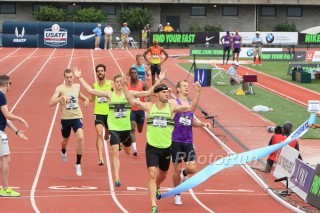
Run Gum, a company co-founded by U.S. track star Nick Symmonds, has filed an antitrust lawsuit in Eugene, Ore., against USA Track & Field and the United States Olympic Committee, claiming the organizations “jointly agreed to exclude various businesses from sponsoring athletes in return for advertising exposure on athletes’ competition apparel” at the 2016 U.S. Olympic Trials for track and field, which take place in Eugene this summer.
Run Gum wants to sponsor athletes at the Trials in exchange for logo placement on the athletes’ competition attire, which is currently not permitted save for the usual standard marks on the uniforms produced by approved apparel manufacturers, such as Nike.
“We are simply looking to level the playing field,” Symmonds says. “It is completely illogical and unfair to allow a very small sector of the market to have total control over the advertising space on an athlete’s competition uniform.”
Symmonds is a two-time U.S. Olympian, the silver medalist at the 2013 IAAF World Championships and a contender to make his third Olympic team this year, but he has made headlines lately as a champion for athletes’ rights. He qualified for the 2015 IAAF World Championships in the 800m but was left off the team over a dispute on the USATF statement of conditions that was mandatory for each athlete to agree to prior to accepting his or her spot on the team. Symmonds contended the contract violated the conditions of his individual sponsorship agreement with Brooks Running.
Leading up to the 2012 U.S. Olympic Trials, Symmonds sold advertising space on his shoulder to Milwaukee-based advertising agency Hanson Dodge Creative, but was forced to cover up the temporary tattoo during competition or risk disqualification. At last year’s national championships, Symmonds broke the finish line tape in the 800m flexing his biceps, adorned with Run Gum temporary tattoos.
To help with the lawsuit, Run Gum has retained the services of antitrust specialists Hausfeld LLP—a firm known for its representation of Ed O’Bannon in the landmark antitrust lawsuit against the NCAA. When Sports Business Daily reached out to USATF about Run Gum’s lawsuit, spokesperson Jill Geer said “We are unaware of the lawsuit and have not been served. In any circumstance, we do not comment on pending litigation.”
News of the lawsuit was widely discussed on social media Wednesday. Performance drink manufacturer BeetElite tweeted, “Huge for all non-apparel sport products. Massive appreciation for everything @RunGum & @NickSymmonds are doing.”
Run Gum is a sports supplement brand selling performance chewing gum with caffeine. Symmonds co-founded the company with his coach, Sam LaPray, in 2014.
“At Run Gum, we believe that people matter and performance matters,” LaPray said of the lawsuit. “We have helped to motivate and fuel thousands of athletes, and now we want to put cash in their pockets and help them achieve their Olympic dreams.”
The post Nick Symmonds’ Company Run Gum Sues USATF, USOC appeared first on Competitor.com.
The Link Between Vitamin D and Athletic Performance

This time of year it can seem like the sun is a myth you only hear about but never actually experience. If you run early in the morning or in the evening—spending all day in an office in between—it’s easy to miss even the slightest hint of natural light. That can make you feel sluggish, chronically sick and slightly depressed. It can even make you run slower.
A growing body of research has found a number of negative health effects resulting from a lack of sunlight, and a lack of corresponding Vitamin D. These range from poor bone density to weak immune systems to links to diabetes and cardiovascular disease. There is increasing research, as well, that suggests Vitamin D deficiencies can impact athletic performance.
“We know that Vitamin D is important for optimal skeletal and muscle function,” says D. Enette Larson-Meyer, an associate professor at the University of Wyoming, who has studied Vitamin D extensively and wrote a review of its athletic importance for the Gatorade Sports Science Institute.
One study found improved sprint times in soccer players. Another suggested that muscles get stronger with increased Vitamin D intake. There’s even some suggestion that sunnier months (and places) correlate with improved oxygen uptake.
In fact, in the 1950s the Eastern bloc countries were so convinced of the link between Vitamin D and athletic performance that they stuck their athletes in front of sunlamps. Those runners improved their 100m times by 7.4 percent, compared to a 1.7 percent improvement for non-sunned runners. There was even a temporary dispute over whether loading up on Vitamin D amounted to cheating, explains John Cannell, a doctor who was so convinced of the benefits of Vitamin D that he founded the Vitamin D Council. (He also wrote the book on the subject, Athlete’s Edge: Faster, Quicker, Stronger with Vitamin D.)
To a degree, some of the reasons Vitamin D might make you faster, quicker and stronger are relatively straight-forward. The vitamin, which isn’t even really a vitamin, primarily comes from direct sunlight absorbed through the skin. (There are also a few minor food sources, such as fatty fish and fortified dairy products, like milk.) It then helps you absorb calcium. Calcium is necessary for healthy bones. So, without enough Vitamin D, your bones are more likely to fracture. This is not good for runners who want to stay uninjured. “It’s especially important for athletes,” says Emily Brown, a former professional runner and a wellness dietician for the Mayo Clinic. One study of NFL players found that those with Vitamin D deficiencies were more likely not just to have fractures, but to be cut from the team.
RELATED: Vitamin D—A Key To Endurance Sports Performance
Vitamin D also keeps your immune system functioning well. That means that Vitamin D-deficient athletes, who often already have weakened immune systems because of training loads, tend be sick more frequently. Sick athletes are not happy athletes. Improving your bone health and your immune health “will translate into more high-quality training days,” says Larson-Meyer.
The other more complicated and less well-understood benefit has to do with muscle function. The vitamin actually operates as a hormone. It regulates processes within your muscular system and keeps inflammation down. People who have Vitamin D deficiencies tend to complain about general muscle soreness. And one study of ballet dancers found that muscle strength and vertical jump improved after a four-month Vitamin D supplement regime.
But a lot about how Vitamin D works and how much is good isn’t fully understood yet. “Maybe it’s Vitamin D. Maybe it’s Vitamin D and something else,” says Larson-Meyer. “But the evidence is pretty strong that Vitamin D does something to optimize performance.”
The one thing we do know is that you probably aren’t getting enough.
Vitamin D deficiencies are rampant in the U.S., says Cannell, since we are a society that mostly works indoors and, as more has been understood about skin cancers, one that also generally slathers on the sunscreen. That’s not a bad thing, but it may be too much of a good thing. What has surprised researchers is that even runners, who spend a decent amount of time outside, have been found to be very low in Vitamin D.
That doesn’t mean we should start doing all our runs with no clothes and no sunscreen. “You don’t want to think of your training time as also your time to get Vitamin D,” says Brown.
All you really need is about 10 minutes of direct high sun on your full body a few times per week—just your face and hands won’t be enough. The rule of thumb, explains Larson-Meyer, is that you need half the time it takes before you start to turn pink, about three times per week. That varies depending on how far north you live and your genes, but for most of us that means just 10-20 minutes at a time.
In the winter, though, even 10 minutes outside without a coat or hat sounds cold and miserable. “Those are times you maybe want to focus on dietary sources,” says Brown, and possibly take a supplement. It’s not 100 percent clear yet if supplements have the same full effect as natural Vitamin D from the sun, according to Cannell. “We don’t know for sure,” she says. But it’s better than nothing.
The only problem is that Vitamin D is a fat-soluble vitamin. That means both that you need some fat in your diet in order to process the mineral, and that it is possible to overdose and hit a toxic level. Most people aren’t anywhere near that level, but that’s why Larson-Meyers advises anyone concerned about their Vitamin D level to get a blood test to see where they’re at before they start taking supplements.
The federal government recommends your level be at 20 nanograms per milileter, but Cannell says 40-50 ng/ml is optimal. If you’re low, you can take supplements, but recommendations on those vary as well. Larson-Meyers suggests taking 1,500-2,000 IU/day; Cannell recommends up to 5,000 IU/day. Natural levels, Cannell argues, come from when we were a more outdoors society.
“Do you want to be like a computer programmer, or a hunter-gather?” he asks.
RELATED: 7 Supplements That Aren’t A Waste of Money
The post The Link Between Vitamin D and Athletic Performance appeared first on Competitor.com.
January 19, 2016
Can Positive Memories Impact Performance?
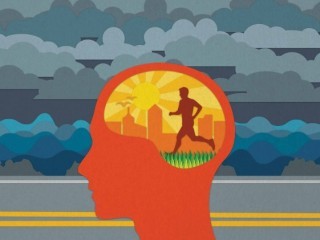
Illustration: Oliver Baker
This article first appeared on Triathlete.
A workout gone wrong can make you wish you never had to put on a pair of running shoes again. New research suggests that we ought to simply shelve those negative memories and spend more time thinking about the runs that went right. The study, published in the journal Memory, discovered that recalling a positive past exercise experience can actually help motivate a person to exercise more. In surveying 150 college athletes, those who were coached on conjuring up a positive memory associated with past training logged more exercise over the week-long study than those who didn’t recall such an experience.
Adrienne Langelier, a mental performance consultant based in Magnolia, Texas, says that we should all have a highlight reel of great workouts and races ready to access at any given time. “Recalling past positive experiences for evidence that your future experience will be favorable is important,” she says.
RELATED: 5 Ways to Mentally Prepare for Your Next Race
With the runners she consults, she often has to do some work to get them to shift from dwelling on the negative to focusing on the positive. “You want to see the race you ran well, instead of the one that didn’t work out,” Langelier explains.
When you have a reel of positive images flicking through your mind, you’re more likely to relax and run your best during a workout or race. “On the starting line, you want to have some key experiences ready to access before the gun goes off to give you a boost in confidence,” she says. “Then you’re more likely to turn some of that race-day anxiety into excitement.”
RELATED: Comfort in Discomfort: Why Mental Practice Matters
The post Can Positive Memories Impact Performance? appeared first on Competitor.com.
Workout Of The Week: Descending Tempos
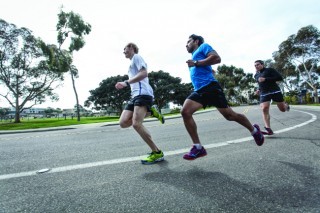
Variation: To mix things up, run half of your pickups on the roads and the other half on the trails or track. Photo: Scott Draper/Competitor
It’s a truism amongst running coaches that no one has all the answers. Many training articles share one particular coaching philosophy with its readers and then supplement the theory with sample schedules for the reader to go mimic on his or her own.
Improving your running, however, is never that simple. There isn’t one cookie-cutter way to improve your aerobic base, fine-tune your speed or set new PRs. The same workout or training program doesn’t work for everyone. This is why some elite runners switch coaches and why coaches are always looking for new ways to train.
If you’re experiencing stagnant race results or just want to try something new in your training, give one of our workouts of the week a shot. It might just be the change in stimulus you need to take your running to the next level.
Descending Tempos
The coach: Pete Rea of Zap Fitness, Blowing Rock, N.C.
The athlete: Alissa McKaig, 8th at the 2012 U.S. Olympic Marathon Trials
When they did it: McKaig completed this taxing workout twice in the last seven weeks of her training before the U.S. Olympic Trials Marathon in 2012. Her last descending tempo workout was done 10 days before the race and ended up being a major confidence booster. At the Trials race, McKaig set a 5-minute PR, clocking 2:31:56 to finish eighth.
Why they did it: According to Rea, this workout develops a runner’s anaerobic threshold, which is the point where the body is working so hard it can’t keep up with its oxygen demands. Rea says this workout helped improve McKaig’s running economy and allowed her to run more efficiently at a faster pace.
How they did it: This workout was done at the end of McKaig’s 30K runs. It entails starting out with 7 minutes of harder running at roughly half-marathon pace, followed by 3.5 minutes of jogging recovery (half the total time spent running hard), then 6 minutes of faster running, followed by 3 minutes of rest, then 5 minutes of hard running with 2.5 minutes of rest, continuing that pattern with fast running for of 4-, 3-, 2- and 1-minute intervals and corresponding rest breaks equal to half of the previous hard session. Rea has all his of his runners complete this workout and says that it’s a good workout for anyone from a miler to a marathoner.
How you can apply the workout: This is a good early- to mid-season workout. Rea suggests that you start out your first segment of faster running at 10-15 seconds slower than your current 10K fitness and gradually get faster with each pickup. The first time you try this workout, you may not be able to complete a count down from 7 minutes to 1 minute, so it’s better to start at 4 or 5 minutes, Rea suggests. A common mistake that runners make is going out too fast and not being able to finish the workout. Rea says you should make sure your opening tempos are under control. If you run this workout, the hard running segments should gradually increase in pace. Another way to mix up this workout is to run half of your pickups on the roads and finish the last few on the track, where it’s easier to run at a consistent pace when you are most fatigued.
The post Workout Of The Week: Descending Tempos appeared first on Competitor.com.
Tech Trends: A Deeper Dive Into The Nike+ Running App
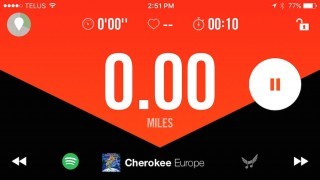
In a previous edition of Tech Trends, we introduced three of our favorite GPS running apps. Over the next few columns, we’ll go into more depth about what makes each of them worth considering on your next run. Up this week: the Nike+ Running app.
Nike, the world’s largest suppliers of athletic shoes and apparel, are concentrating their digital efforts on apps and software. Instead of continuing to sell the Nike+ GPS running watch and FuelBand fitness tracker, Nike has chosen to refine their app offerings for smartphones and smartwatches (and no worries non-Nike shoe wearers—you can where whatever brand of shoes you want on your feet to take advantage of the app’s features).
An Abundance of Free Features on Nike+
While Nike+ Running lacks a few of the options found with Strava and Runkeeper, the app comes with a very useful set of features for no cost. Plus, there is no “premium” version of the app so you’ll never receive annoying prompts asking you to upgrade to a paid version.
Along with the ability to record the time, distance and map of your run, the Nike+ Running app has coaching, challenge, social features and device/third-party integrations.
For the coaching component, Nike+ Running includes general training plans from 5K to marathon for beginning to advanced level runners. Though not customized, the plans are very detailed and vary in length from 8 weeks to 24 weeks depending on the goal race.
The app also has a couple of ways to make your running a bit more social. In the Friends tab, a running leaderboard ranks your monthly mileage versus your Nike+ Running friends. In Challenges, you can set a mileage total and invite your friends to fight over who can get to that mileage goal first.
Nike+ Running also features a couple of nice device and technical integrations. If you have the Apple Watch, you can keep your iPhone in your pocket and have information from the run relayed to your wrist. Nike+ Running also pulls fitness data from Garmin Connect, TomTom and Wahoo to put all of that information in one place.
RELATED: Which GPS Running App Is Right For You?
Better Feedback on the Run
While this may sound like a small detail, the ability to adjust the orientation of the screen from portrait to landscape mode in the Nike+ Running app is very useful. Reading your phone’s screen while it’s strapped to your arm at any pace is difficult, but when running data is displayed in landscape mode it’s easier to see. Along with improved orientation, the app’s text is provided in a large, readable font.
For those who run with Bluetooth earbuds, or if you simply don’t want to look down at your arms during a run, the app provides audio feedback about total time, distance and pace. This information can be set up to provide information at a variety of time and mileage intervals: 0.25, 0.5, 1, 2 miles or 1, 5, 10 and 15 minutes. Sorry metric system fans, it doesn’t feature kilometers.
A Small Price to Pay for Motivation
While Nike+ Running features are free, my favorite one requires a paid Spotify Premium account ($9.99/month). Runners with Spotify Premium can link up with the Nike+ Running app to generate a personalized mix of songs called a Pace Station. After selecting a target pace and the artist or genre of music, a custom station is created. After selecting 8:15/mile and the Rock genre, I spent a 3-mile run listening to a mix of KISS, Led Zeppelin and Robert Plant.
After setup, creating a new or selecting previous Power Stations is very simple. I’ve played around with some other paces, music genres and find the selection of songs to be very upbeat and motivating. Those with a Premium Spotify account will greatly appreciate this feature.
RELATED: An Introduction To Strava
The post Tech Trends: A Deeper Dive Into The Nike+ Running App appeared first on Competitor.com.
2016 U.S. Olympic Trials Marathon Qualifiers by the Numbers
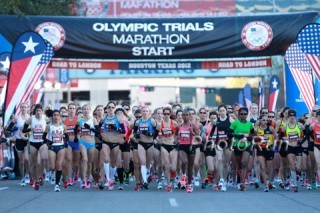
Photo: PhotoRun.net
A total of 455 runners have qualified for the U.S. Olympic Trials Marathon on Feb. 13 in Los Angeles. How many end up racing remains to be seen.
The final list, compiled by USATF, is broken down by how the runner qualified and if the “A” or “B” standard was met. For men, the “A” standard was a 2:15:00 marathon or faster, and the “B” standard was a marathon between 2:15:01 and 2:19:00 or a half marathon at 1:05:00 or faster. For women, the “A” standard was a 2:37:00 or faster marathon with the “B” standard between 2:37:01 and 2:45:00 or a half marathon at 1:15:00 or faster.
In all, 244 women and 211 men qualified. The men saw much more success qualifying via the half marathon, with 125 men getting in that way (59 percent) compared to just 48 women (20 percent). Just 86 men qualified through their marathon time, compared to 196 women.
A total of 27 men and 41 women obtained the “A” standard. Runners who meet the “A” standard get financial support from USATF to help with travel to the race.
The final tally means that about 20 runners secured their invitation on the last weekend to qualify, with races like Rock ‘n’ Roll Arizona and the Houston Marathon and Half giving runners one last chance. The Naples Daily News Half Marathon was set up to provide a last-minute ticket, as well, but a nasty storm forced the race to be canceled.
Runners have until Jan. 31 to register for the Olympic Trials marathon. Race officials reported last week that 353 runners have signed up so far.
The post 2016 U.S. Olympic Trials Marathon Qualifiers by the Numbers appeared first on Competitor.com.
Nike Launches NikeWomen Victory Tour Race Series
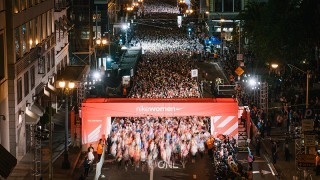
Following last December’s announcement that its wildly popular women’s half marathon would not be returning to San Francisco in 2016, Nike revealed a new race series on Tuesday called the NikeWomen Victory Tour that will kick off on March 13 in Nagoya, Japan.
The new NikeWomen Victory Tour consists of 10K to marathon Nike+ Run Club (NRC) Races, five-hour-long NTC Tour training experiences and other unique events. It runs through September and stops in 20 cities around the world—most of which have hosted (or will host) the Summer Olympics—including Rio de Janeiro, Shanghai and Tokyo. The American cities listed include Los Angeles and Atlanta.
“Inspired by Nike, the winged goddess of victory, the NikeWomen Victory Tour is the largest women’s event series in the world,” Nike said in a press release. “Moreover, it celebrates personal victories through sport, inspiring athletes to push themselves and be better for it.”
Each NRC Race will feature a range of perks and experiences, including new race courses and services such as access to NRC Coaches, bra fitting and product trials. The NTC Tour stops will include a variety of workouts led by Nike Master Trainers. Cities not hosting NRC Races or NTC Tour stops will invite women to experience unique running or training events with Nike Master Trainers, NRC Coaches or elite athletes. Registration opens January 29 for most cities.
The post Nike Launches NikeWomen Victory Tour Race Series appeared first on Competitor.com.
London Marathon Features Star-Studded Elite Men’s Field
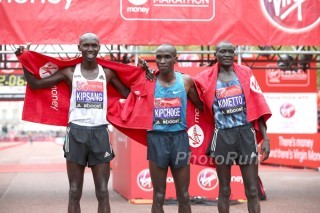
Photo: PhotoRun.net
(c) 2016 Race Results Weekly, all rights reserved. Used with permission.
Befitting an Olympic Year, organizers of the Virgin Money London Marathon announced a blockbuster men’s elite field for the 36th edition of their race—Britain’s largest marathon— on Sunday, April 24. The field includes current champions of the Berlin, London, New York, Rotterdam, Tokyo, and World Championships marathons; eight men who have broken the 2:06 barrier; and the present and previous world record holders.
Topping the athlete list are the first five men to finish last year’s race (in order): Kenyans Eliud Kipchoge, Wilson Kipsang, Dennis Kimetto, and Stanley Biwott, and Ethiopia’s Tilahun Regassa. Kipchoge —the No. 1-ranked marathoner by Track & Field News for 2015 with victories in both London and Berlin—ran the two fastest times in the world last year: 2:04:42 at London and 2:04:00 at Berlin. He is the points leader of the Abbott World Marathon Majors Series IX which concludes at the Tokyo Marathon next month. Coached by Patrick Sang, Kipchoge has five marathon victories in six starts.
“It was fantastic to win the Virgin Money London Marathon last year against one of the greatest fields ever assembled in marathon running,” Kipchoge said through a statement provided by race organizers. “This year I will come back to London to compete again with the world‘s best athletes. I will work hard to defend my title in London and, together with Wilson, Dennis, Stanley and those from other countries, make it a fast and wonderful race.”
RELATED: 2016 London Marathon Boasts an Incredible Elite Women’s Field
Kipsang, the former world record holder with a 2:03:23 personal best, was the London champion in both 2012 and 2014. He was also the TCS New York City Marathon winner in 2014, and took fourth last year.
Kimetto is the current world record holder and the only man to break 2:03 in the marathon with his 2:02:57 in Berlin. In London, he’ll be trying to rebound from a disappointing second half of 2015 in which he dropped out of both the IAAF World Championships and Fukuoka Marathons.
Biwott is the reigning TCS New York City Marathon champion and has a career best time of 2:04:55. He recently won the Sao Silvestre Road Race over 15 kilometers in Sao Paulo, Brazil, on 31 December.
Regassa is an erratic athlete with a solid marathon best of 2:05:27, but an even better half-marathon PR of 59:19. He won the Rotterdam Marathon in 2013 and the Eindhoven Marathon in 2014.
There are other outstanding athletes in the race, like three-time Olympic gold medalist Kenenisa Bekele of Ethiopia, reigning world marathon champion Ghirmay Ghebreslassie of Eritrea, national marathon record holder Arne Gabius of Germany, nine-time European Cross Country Championships gold medalist Serhiy Lebid of Ukraine, and and 10,000m and half-marathon ace Bedan Karoki of Kenya who will be making his marathon debut.
“With the world record holder, the world champion, and our own course record holder Wilson Kipsang racing, Eliud knows he will have to be at his best,” said event director Hugh Brasher in a statement. “It should be thrilling to watch.”
The race also serves as the U.K. Athletics trial for the Rio Olympics. The first two British athletes to cross the finish line on The Mall will be nominated for team selection, provided they have achieved a mark of 2:14:00 or better during the U.K. Athletics qualifying period (the team will be announced the day after the race). Top British entrants include Chris Thompson, Scott Overall, and Callum Hawkins. Thirteen British men have entered.
“And with the Rio Olympics fast approaching, the battle to be top Briton should be equally enthralling,” added Brasher.
RELATED: Photos: 2015 London Marathon
The post London Marathon Features Star-Studded Elite Men’s Field appeared first on Competitor.com.
Ryan Hall's Blog
- Ryan Hall's profile
- 21 followers



